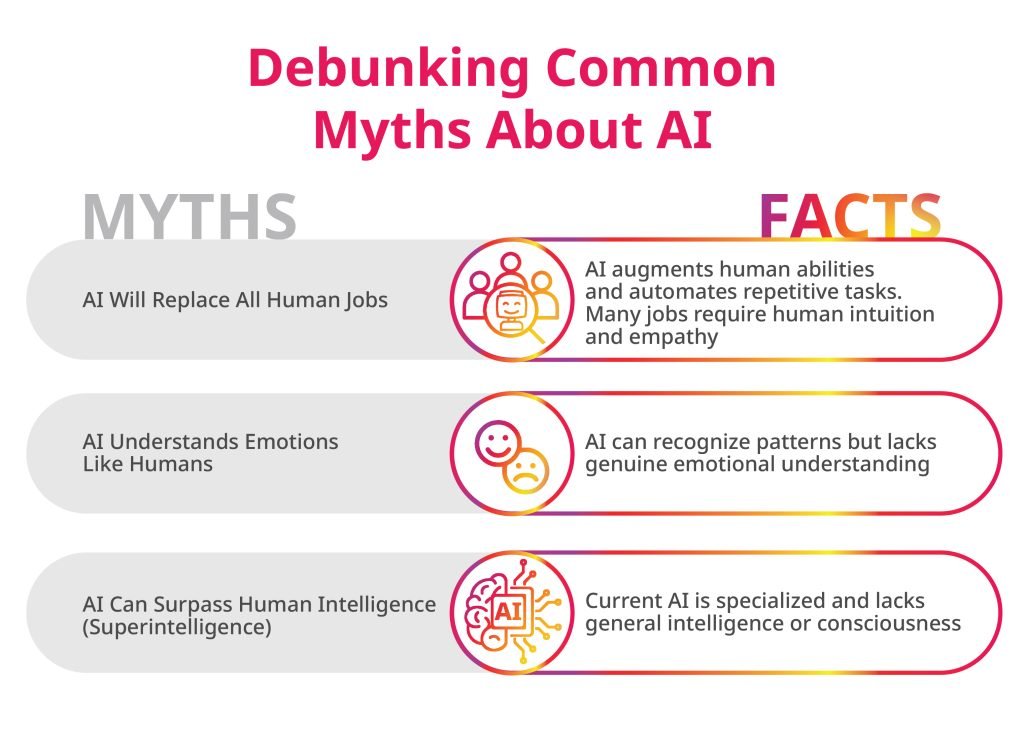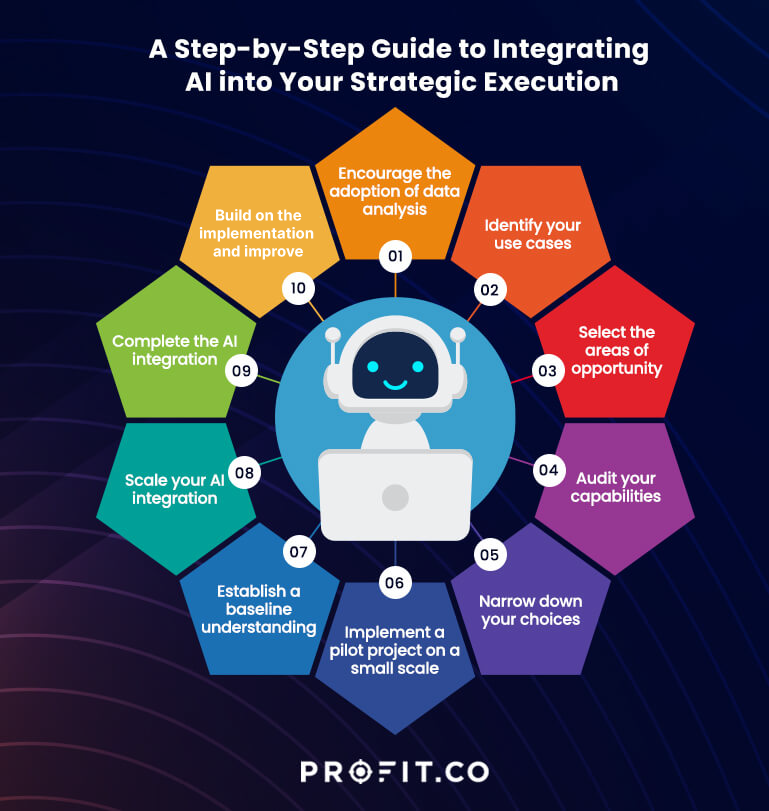
Breaking AI Myths to Harness Its Power in the Modern Workforce
Alongside the meteoric rise of AI in business, a complimentary wave of AI myths have begun clouding the promise of positive applications. One of the most pervasive myths is the belief that AI will replace entire teams, including L&D departments. Such fears, often fueled by dramatic portrayals in popular media, overlook the nuanced reality of AI’s current capabilities and its potential to complement rather than replace human roles.
As organizations look ahead to fuller integration of AI into their workforce strategies, it’s crucial to address these misconceptions to fortify employee buy-in. This article explores prevalent AI myths and highlights how alternate perspectives can demystify AI’s impact.
Myth #1: AI will surpass human intelligence
One of the most persistent misconceptions about artificial intelligence (AI) is that it surpasses human intelligence. At first glance, it may appear that AI, with its impressive capabilities in computation and task execution, outshines human intellect. However, this perception is misleading.
AI can outperform you in a trivia game or churn out data at a speed that makes your laptop look like a clunky abacus. But let’s not mistake raw computational power for actual wisdom or insight. AI systems, particularly those driven by large language models, operate through complex algorithms and vast datasets. They excel in specific tasks, such as pattern recognition and data processing, where they can often outpace human performance. For instance, AI can analyze large volumes of information rapidly and generate outputs based on recognized patterns. Yet, this proficiency does not equate to genuine understanding or creativity.
One critical flaw in the argument that AI is “smarter” than humans lies in the lack of contextual and nuanced comprehension inherent in AI systems. While AI can mimic human-like responses and produce seemingly intelligent outputs, it fundamentally lacks the ability to grasp context in the way humans do. This deficiency is not merely a technical shortcoming but a profound limitation. AI’s responses are confined to the patterns and information it has been trained on, making it unable to fully appreciate or adapt to novel contexts.
Moreover, AI’s reliance on data and algorithms means it is heavily dependent on the quality and scope of its training data. Unlike human intelligence, which is capable of intuitive leaps and abstract thinking, AI lacks the capacity for these cognitive processes. It operates within the bounds of its programmed parameters and cannot extend beyond them to exhibit true creativity or innovative thought.
Human intelligence, in contrast, encompasses a broad spectrum of capabilities beyond logical reasoning. It includes empathy and ethical judgment. Also, humans learn from a wealth of experiences and adapt their knowledge and behavior accordingly. AI, however, learns in a more rigid manner, relying on pre-existing data without the capacity for experiential growth.

[Image Source: Commtel Networks]
While artificial intelligence undeniably stands out as a remarkable technological advancement, it has yet to ascend to the realm of superior intelligence. AI can indeed demonstrate exceptional proficiency in particular tasks and deliver impressive performance metrics. However, it remains devoid of the creative intuition, emotional nuance, and ethical discernment that define genuine human intelligence.
Myth #2: AI will make L&D teams obsolete
A common misconception about generative AI (Gen AI) is that it will render entire L&D teams obsolete. This fear, while not unfounded given the rapid pace of technological advancement, misrepresents the actual capabilities of AI. Unlike the sentient robots depicted in science fiction, current AI systems are examples of Narrow AI, designed to perform specific tasks rather than exhibit general intelligence or consciousness.
AI’s primary function in L&D is not to replace human expertise but to augment it. The ‘AHAH’ principle—AI-assisted, Human-led, AI-resourced, Human-checked—embodies this approach. AI tools assist in content creation and resource management, but human oversight remains crucial. This balanced approach ensures that while AI enhances efficiency, the human touch in critical thinking, emotional intelligence, and nuanced judgment remains indispensable.
Myth #3: AI can’t be used for learning personalization
Another prevalent AI myth is that generative AI lacks the capability to deliver personalized learning experiences. The reality is that AI technology is evolving, moving from Gen AI to Synthetic AI (Synth AI), which significantly enhances personalization. Synth AI goes beyond simple content generation to include sophisticated synthesis and analysis, tailoring learning experiences to individual needs based on extensive data inputs.
With Synth AI, L&D teams can revitalize existing content and align it with current learner needs. This capability allows organizations to deliver highly contextual and relevant learning experiences at a scale. For example, Synth AI can breathe new life into legacy content by contextualizing it according to contemporary business needs, thus expanding the scope and relevance of learning programs.
Myth #4: AI can’t be used for skill development
There is a myth that AI is inadequate for teaching complex skills, particularly those requiring emotional intelligence or nuanced interpersonal interactions. Contrary to this belief, AI can play a pivotal role in developing both technical and soft skills. Through Natural Language Processing (NLP), AI can analyze communication patterns and provide valuable feedback, aiding in the development of critical soft skills such as leadership and conflict resolution.
Moreover, AI can create immersive virtual scenarios for skill practice, offering a safe environment for learners to refine their abilities. These virtual simulations provide practical, hands-on experience without the risks associated with real-world applications, thus enhancing both technical proficiencies and interpersonal skills.
Maximizing AI’s value: Strategic implementation for driving growth bursting AI myths
To drive growth and realize a return on AI investments, businesses must focus on three critical value drivers: placing humans at the center of their operations, leveraging technology at speed, and enabling innovation at scale. AI offers long-term benefits such as enhanced customer centricity, agility, and predictive insights. Companies should start by evaluating their long-term relevance and growth aspirations, then strategically incorporate AI to meet these goals.
Organizations that integrate AI into their core processes can gain competitive advantages and operational efficiencies. By embedding AI into legacy systems and addressing security risks through robust training programs, businesses can accelerate their AI strategy and realize quicker value gains.
However, despite AI’s potential, some companies remain cautious about integrating it into core operations. Security risks and a general lack of understanding of AI’s capabilities often result in these technologies being deployed in isolated business units rather than central functions. To dispel these doubts, businesses need to deepen their understanding of AI’s benefits, invest in strong data infrastructure, and build trust through transparent change management. It’s a classic case of “know your stuff before you dive in”.

[Image Source: Profit.Co]
A significant hurdle for many organizations is the internal skills gap, affecting 27 percent of businesses. This shortage is particularly glaring in sectors like healthcare, where 78 percent of companies report a severe deficit of relevant expertise. Without the right talent, deploying and managing AI technologies effectively becomes a Herculean task.
Addressing this skills gap requires a focused investment in training and development programs that emphasize AI and digital competencies. Companies should consider collaborating with educational institutions or technology providers to gain access to specialized knowledge and resources.
In a nutshell bursting AI myths maximizing AI’s value demands a strategic approach that integrates these technologies deeply into core operations while addressing security and skills challenges. Embracing AI with a clear, well-supported strategy can drive growth and transform business operations in ways that are both innovative and efficient.
In brief
Overcoming the barriers to AI adoption requires a multifaceted approach that addresses cultural, technological, organizational, and skills-related challenges. By fostering a culture of innovation, modernizing legacy systems, enhancing cross-departmental collaboration, and addressing internal skills gaps, organizations can pave the way for successful AI integration. With strategic planning and commitment, organizations can unlock the full potential of AI and achieve a competitive edge in the digital economy.